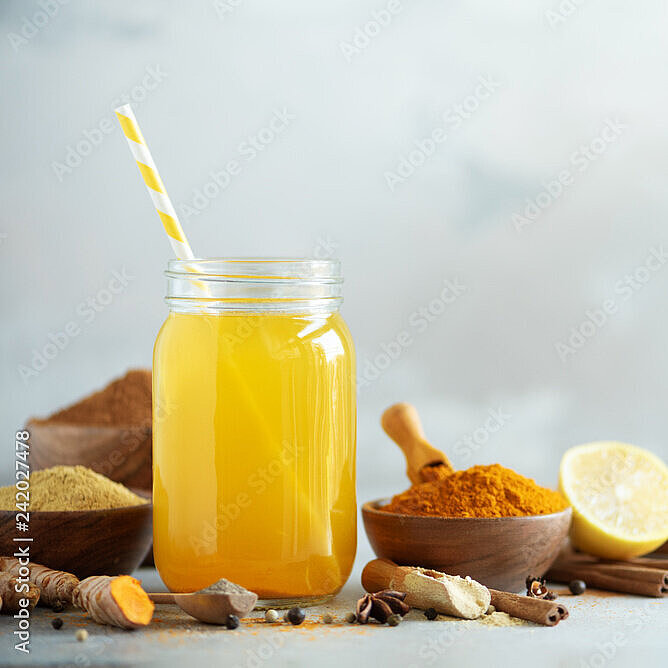
Anti-inflammatory foods
What diet is beneficial in rheumatism or psoriasis? Different scientific studies show that adapting your diet to recommendations for inflammatory diseases of the joints and skin can make a positive contribution to your general state of health. Consuming foods that contain anti-inflammatory substances helps. But which ones are they? And do they actually have a preventative effect on the development of inflammation? Find out more here
The most important tips on nutrition for rheumatoid arthritis or psoriasis
Nutrition is not only a matter of taste, but also very individual. What is good for one person does not necessarily help another. Nevertheless, there are a few general guidelines that should be taken into account when choosing food – especially when it comes to the diet of patients with rheumatoid arthritis or psoriasis.
The food pyramid shows at a glance which foods should end up on your plate frequently and which should be eaten less often.
Which nutrients fuel inflammatory processes?
It is now known that certain nutrients have a negative or ‘firing up’ influence on inflammatory processes in the body. These inflammatory processes are mediated by certain messenger substances in the body, some of which are directly related to diet. For example, arachidonic acid, which is ingested via animal foods such as meat, eggs, or high-fat dairy products, leads to such a promotion of inflammation.
For inflammatory joint diseases such as rheumatoid arthritis, a diet low in arachidonic acid and consisting mainly of plant-based foods is therefore helpful. Omega-3 fatty acids fulfil different functions regarding the health of bones and joints. They belong to the important substances that the body cannot produce itself, or only in insufficient quantities. In contrast to the arachidonic acid mentioned above, omega-3 fatty acids have an anti-inflammatory effect.
Omega-3 fatty acids, which are mainly contained in fish oils, are also said to have a pain-relieving effect. Sea fish with a high fat content, such as mackerel or salmon, should therefore be eaten as a matter of preference. For people with rheumatoid arthritis who do not want to eat fish or fish oil every day, appropriate dietary supplements are available. Vegetable oils with omega-3 fatty acids such as linseed oil, rapeseed oil, walnut oil, or whole seeds and nuts are also recommended.

Sugary foods are not part of an anti-inflammatory diet
Carbohydrates are the foods we consume the greatest amount of. Fruit, vegetables, and cereals contain important dietary fibres and are an important part of diet. Simple carbohydrates from white bread, pasta or rice should nevertheless only be eaten in moderation, unless the wholemeal variety is chosen. Fast-digesting carbohydrates such as sugary foods cause blood sugar levels to rise and can thus have a negative effect on skin appearance, especially in psoriasis. They should therefore only be eaten in small quantities.
Bad for rheumatoid arthritis or psoriasis: | Good for rheumatoid arthritis or psoriasis: |
| short-chain, simple carbohydrates | long-chain or complex carbohydrates |
|
|
These provide energy quickly and go into the blood immediately, the blood sugar level rises sharply and falls again just as quickly. | These provide the body with fibre and minerals as well as plenty of energy. Complex carbohydrates cannot be converted into glucose immediately by the body. That is why they saturate over a longer period of time. |
Mediterranean diet helps with chronic inflammatory diseases
Eating animal protein mainly in the form of fish is part of the so-called ‘Mediterranean diet’. This diet is low in fat and high in fish, vegetables and healthy fruit. Due to the low meat content, this type of diet is also good for people with chronic inflammatory diseases and has a positive effect on the cardiovascular system. Other valuable vegetable protein sources are nuts and pulses. The latter also contain plenty of well-satiating carbohydrates.
Along with carbohydrates and protein, fat is also one of the energy-providing macronutrients and should therefore not be missing from any diet. However, it is important to distinguish between ‘good’ and ‘less good’ fats. Monounsaturated fatty acids, such as those found in olive oil, have a favourable effect on inflammation. Walnut, wheat germ, rapeseed and linseed oil are also recommended as they contain high-quality fatty acids. Trans fats in animal and processed foods such as crisps or biscuits, on the other hand, can be conducive to inflammation in the body.
Drinking enough, ideally in the form of calorie-free or low-calorie drinks, is very important. Water and unsweetened teas are good choices. There is no definitive statement on coffee. Soft drinks, milk-based drinks and juice should be avoided or only consumed in small quantities. The general recommendation is 1.5 to 2.5 litres of fluid per day. Ideally, you should avoid alcohol. It makes sense to drink a small amount more often than too much at once, as the body can only process a small amount per hour.
Avoid high body weight
With increasing body mass index (BMI), the risk of joint damage such as knee joint arthrosis increases. In addition, being overweight can reduce the effect of medicines. It is thus advisable to avoid or reduce very high weight. In psoriasis, a low-calorie diet leads to an improvement of the skin symptoms and also has a positive effect on psoriasis with joint involvement. Try and consume as little convenience food as possible as it contains short-chain carbohydrates, preservatives and often too few nutrients with a high energy density.
Smoking increases the risk of inflammatory rheumatic diseases and negatively influences the response to therapy.
As a precaution, people with psoriasis should avoid hot sauces, because they are suspected of aggravating psoriasis. The same applies to spices such as chili, curry, pepper and cinnamon.

These spices and vitamins are part of the anti-inflammatory diet
Other spices, such as ginger and turmeric, are associated with an anti-inflammatory effect.
A sufficient supply of vitamin D is especially important for people with rheumatoid arthritis. Studies have shown that only about one third of all rheumatoid arthritis sufferers have an adequate supply of this vitamin. Such a deficit increases the risk of osteoporosis. In particular, older people with rheumatoid arthritis should therefore ask their doctors whether they can benefit from vitamin D substitution.
Probiotics: The skin is also a reflection of the gut. Therefore, intestinal rehabilitation in psoriasis can have a positive effect on overall well-being.
Daily diet plan for rheumatoid arthritis or psoriasis
Tip
Many statutory health insurance companies subsidise nutritional counselling for psoriasis patients. Ask your attending specialist for a corresponding certificate of necessity.
Healthy recipes
Recipes to support your well-being
The following recipes are intended to give an insight into the varied cuisine for people with inflammatory diseases such as rheumatism or psoriasis. It is especially important for patients to familiarise themselves with the different foods and their components. In this way, you can find out for yourself what is good for your body or what it reacts to. You can do yourself a lot of good with a balanced and conscious diet.
Skewers of colourful vegetables with tomato sauce
For 2 servings
Vegetable skewers
400 g vegetables (e.g. courgette, pepper, aubergine, spring onions, mushrooms), soy sauce & iodised salt
Tomato sauce
300 g tomatoes, 1 onion, 10 g margarine (non-dairy protein),
½ tbsp tomato puree, 1 clove garlic (crushed), iodised salt
Preparation
Wash and clean the vegetables and cut them into equal-sized pieces. Put the vegetable pieces on wooden skewers, brush with soy sauce and sprinkle with iodised salt. The skewers can be fried in a pan or cooked on the grill.
For the sauce, skin the tomatoes (cut them crosswise and scald them with hot water) and then dice them. Dice the onions. Heat the margarine in a pot and sauté the onions together with the tomatoes. Add the tomato puree and bring to the boil. Season to taste with garlic and salt.
Vegetable potatoes
For 8 servings
8 large potatoes 400 g mushrooms 2 leeks 2 apples Margarine or cheese (milk protein-free) Iodised salt
Preparation
Wash the potatoes and boil them. Take care not to overcook the potatoes as they still need to be scooped out. Clean and slice the mushrooms and leeks. Core the apples and grate them coarsely. Sauté everything in the pot with the margarine.
Hollow out the potatoes with a spoon and add this potato mixture to the vegetables. Season with iodised salt. Then place the hollowed potatoes in a baking dish and fill with the mixture. Finally, put a flake of margarine or cheese on each potato and bake in the oven at 200 °C for about 15 minutes.
Tuna carpaccio
For 8 servings
200 g radish 2 limes 2 pieces fresh ginger (approx.1 cm) 400 g fresh tuna 4 tbsp. soya oil Iodised salt 1 pinch coriander
Preparation
Peel the radish and cut into fine slices, then into strips. Remove the peel from the limes and cut the flesh into small cubes. Remove the seeds.
Peel the ginger and grate finely. Cut the tuna into thin slices with a very sharp knife and drape on a plate.
Mix the radish, the lime cubes and the ginger with the oil and season with iodised salt and coriander. Spread on the tuna and serve immediately.
Sweet banana pancakes
For 8 servings
Batter
200 g oat flour (fine) 200 g spelt flour (fine) Apple juice 80 g melted margarine (milk protein-free) 1 pinch iodised salt 4 mashed bananas 100 g almonds (ground) Possibly a little water Rapeseed oil for baking Apple sauce for serving
Preparation
Mix the oat and spelt flour well with apple juice, iodised salt and mashed bananas.
Cover the batter and leave to rise for about 20 minutes. Add the almonds and some water and mix well.
Heat the oil in a pan and spoon in the batter in batches. Fry the pancakes on both sides over a medium heat.
Arrange on a plate and serve with applesauce.
Oven vegetables with sour cream dip
Ingredients for the oven vegetables
2 tubers beetroot (fresh) 2 potatoes (large) 1 sweet potato (small) Some sea salt 1 sprig rosemary 3 sprigs thyme
Ingredients for the dip
100 g sour cream 100 g curdled cream Half a bunch of parsley Half a bunch of chives Squeeze of lemon A little salt, pepper
Preparation
Preheat the oven to 220 °C. Clean the beetroot, potatoes and sweet potato and cut into slices approx. 1 to 2 cm thick. Place the beetroot in an ovenproof dish, drizzle with olive oil, sprinkle with sea salt and place in the preheated oven. After 10 to 15 minutes, add the potato and sweet potato slices and stir.
Turn the vegetables after 15 minutes.
Finely chop the rosemary and thyme and sprinkle over the vegetables after another 15 minutes. Then bake in the oven for another 15 minutes. For the dip, put the sour cream and curdled cream in a bowl. Chop the parsley, cut the chives into small rolls and mix with the sour cream and curdled cream. Season the dip with salt, pepper and a squeeze of lemon. Remove the vegetables from the oven and serve with the dip.
Cauliflower pizza
Ingredients for the dough
220 g cauliflower 1 Egg 180 g (up to 30% fat in dry matter) cheese 1 clove garlic 1 tsp Italian herbs Salt
Ingredients for the topping
1 package strained tomatoes To taste: vegetables To taste: turkey cold cuts 1.5 handfuls of grated cheese
Preparation
This pizza base is yeast- and wheat-free. The ‘cauliflower flour’ has very few Carbohydrates. Finely chop cauliflower with a grater or in a blender. It should resemble semolina. Pre-cook the cauliflower semolina for about 8 minutes in a steamer or microwave at 600 watts. Preheat the oven to 180 degrees. Chop the garlic and grate the cheese. Mix the egg, cheese, cauliflower, garlic, spices and salt. Spread the mixture on a baking tray lined with baking paper and bake for about 15 minutes until the bottom is lightly brown.
Take the tray out of the oven and spread the strained tomatoes on the pizza base. Top the pizza as desired, for example with spinach and turkey breast slices. Add the cheese and bake for another 10 minutes until the cheese has melted.





